Organizational Culture and its Impact on Employee Motivation: A Case Study of Tesco
VerifiedAdded on 2023/06/18
|15
|3145
|415
AI Summary
This report analyzes the impact of organizational culture on employee motivation using Tesco as a case study. It includes secondary and primary research on Handy's culture model, Maslow's motivational theory, and communication models. The report also evaluates how Tesco can use its culture to enhance its success.
Contribute Materials
Your contribution can guide someone’s learning journey. Share your
documents today.

Secure Best Marks with AI Grader
Need help grading? Try our AI Grader for instant feedback on your assignments.
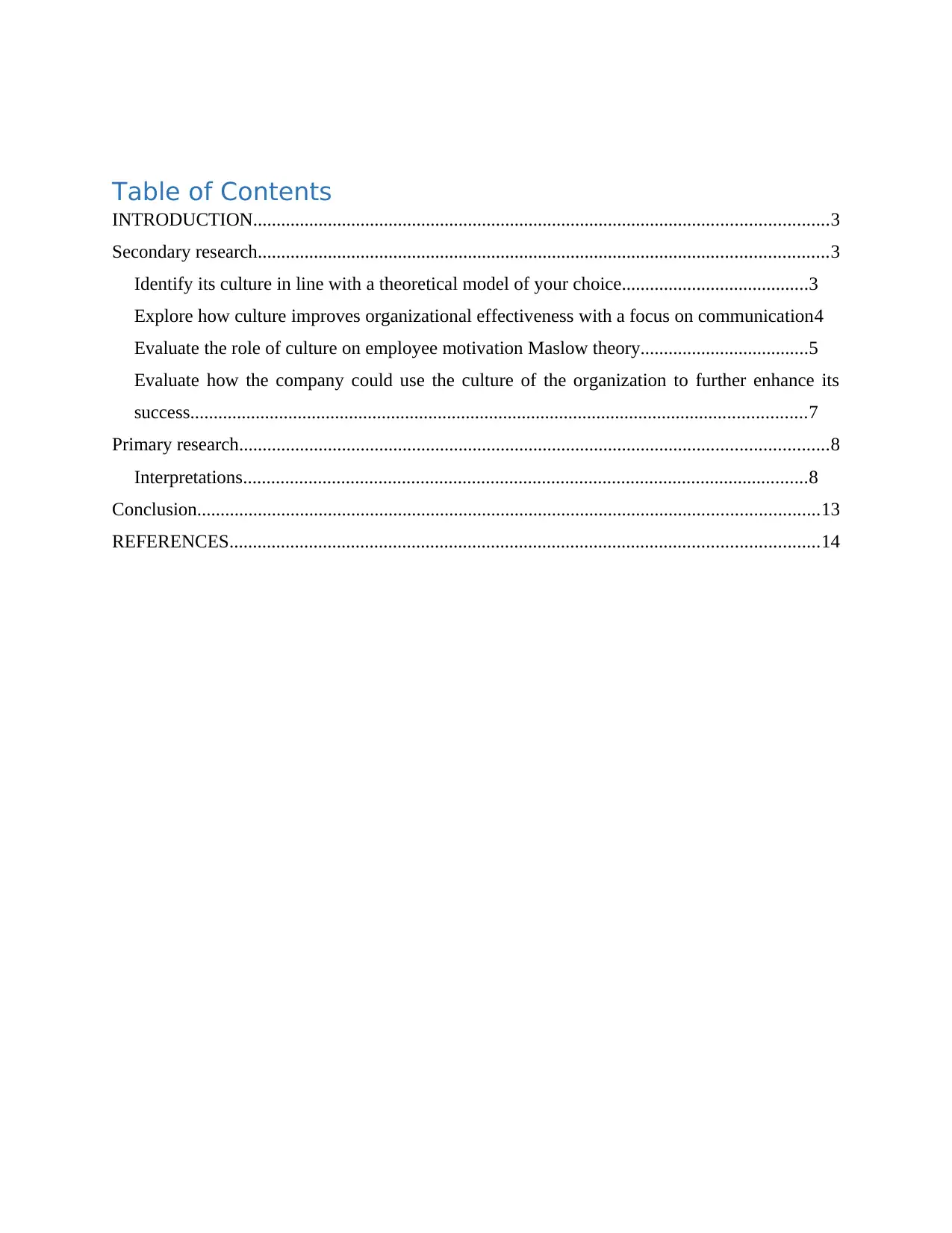
Table of Contents
INTRODUCTION...........................................................................................................................3
Secondary research..........................................................................................................................3
Identify its culture in line with a theoretical model of your choice........................................3
Explore how culture improves organizational effectiveness with a focus on communication4
Evaluate the role of culture on employee motivation Maslow theory....................................5
Evaluate how the company could use the culture of the organization to further enhance its
success....................................................................................................................................7
Primary research..............................................................................................................................8
Interpretations.........................................................................................................................8
Conclusion.....................................................................................................................................13
REFERENCES..............................................................................................................................14
INTRODUCTION...........................................................................................................................3
Secondary research..........................................................................................................................3
Identify its culture in line with a theoretical model of your choice........................................3
Explore how culture improves organizational effectiveness with a focus on communication4
Evaluate the role of culture on employee motivation Maslow theory....................................5
Evaluate how the company could use the culture of the organization to further enhance its
success....................................................................................................................................7
Primary research..............................................................................................................................8
Interpretations.........................................................................................................................8
Conclusion.....................................................................................................................................13
REFERENCES..............................................................................................................................14
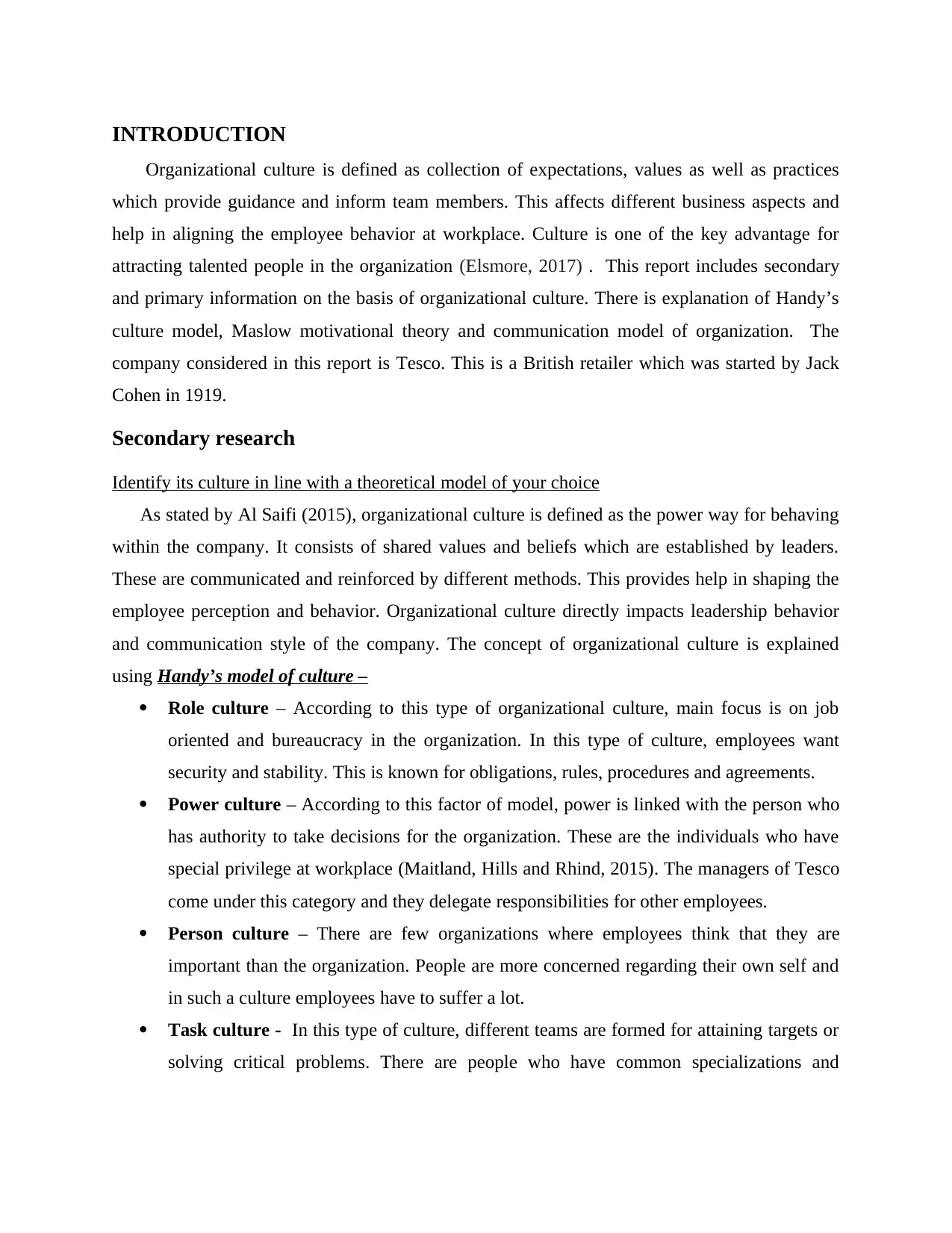
INTRODUCTION
Organizational culture is defined as collection of expectations, values as well as practices
which provide guidance and inform team members. This affects different business aspects and
help in aligning the employee behavior at workplace. Culture is one of the key advantage for
attracting talented people in the organization (Elsmore, 2017) . This report includes secondary
and primary information on the basis of organizational culture. There is explanation of Handy’s
culture model, Maslow motivational theory and communication model of organization. The
company considered in this report is Tesco. This is a British retailer which was started by Jack
Cohen in 1919.
Secondary research
Identify its culture in line with a theoretical model of your choice
As stated by Al Saifi (2015), organizational culture is defined as the power way for behaving
within the company. It consists of shared values and beliefs which are established by leaders.
These are communicated and reinforced by different methods. This provides help in shaping the
employee perception and behavior. Organizational culture directly impacts leadership behavior
and communication style of the company. The concept of organizational culture is explained
using Handy’s model of culture –
Role culture – According to this type of organizational culture, main focus is on job
oriented and bureaucracy in the organization. In this type of culture, employees want
security and stability. This is known for obligations, rules, procedures and agreements.
Power culture – According to this factor of model, power is linked with the person who
has authority to take decisions for the organization. These are the individuals who have
special privilege at workplace (Maitland, Hills and Rhind, 2015). The managers of Tesco
come under this category and they delegate responsibilities for other employees.
Person culture – There are few organizations where employees think that they are
important than the organization. People are more concerned regarding their own self and
in such a culture employees have to suffer a lot.
Task culture - In this type of culture, different teams are formed for attaining targets or
solving critical problems. There are people who have common specializations and
Organizational culture is defined as collection of expectations, values as well as practices
which provide guidance and inform team members. This affects different business aspects and
help in aligning the employee behavior at workplace. Culture is one of the key advantage for
attracting talented people in the organization (Elsmore, 2017) . This report includes secondary
and primary information on the basis of organizational culture. There is explanation of Handy’s
culture model, Maslow motivational theory and communication model of organization. The
company considered in this report is Tesco. This is a British retailer which was started by Jack
Cohen in 1919.
Secondary research
Identify its culture in line with a theoretical model of your choice
As stated by Al Saifi (2015), organizational culture is defined as the power way for behaving
within the company. It consists of shared values and beliefs which are established by leaders.
These are communicated and reinforced by different methods. This provides help in shaping the
employee perception and behavior. Organizational culture directly impacts leadership behavior
and communication style of the company. The concept of organizational culture is explained
using Handy’s model of culture –
Role culture – According to this type of organizational culture, main focus is on job
oriented and bureaucracy in the organization. In this type of culture, employees want
security and stability. This is known for obligations, rules, procedures and agreements.
Power culture – According to this factor of model, power is linked with the person who
has authority to take decisions for the organization. These are the individuals who have
special privilege at workplace (Maitland, Hills and Rhind, 2015). The managers of Tesco
come under this category and they delegate responsibilities for other employees.
Person culture – There are few organizations where employees think that they are
important than the organization. People are more concerned regarding their own self and
in such a culture employees have to suffer a lot.
Task culture - In this type of culture, different teams are formed for attaining targets or
solving critical problems. There are people who have common specializations and
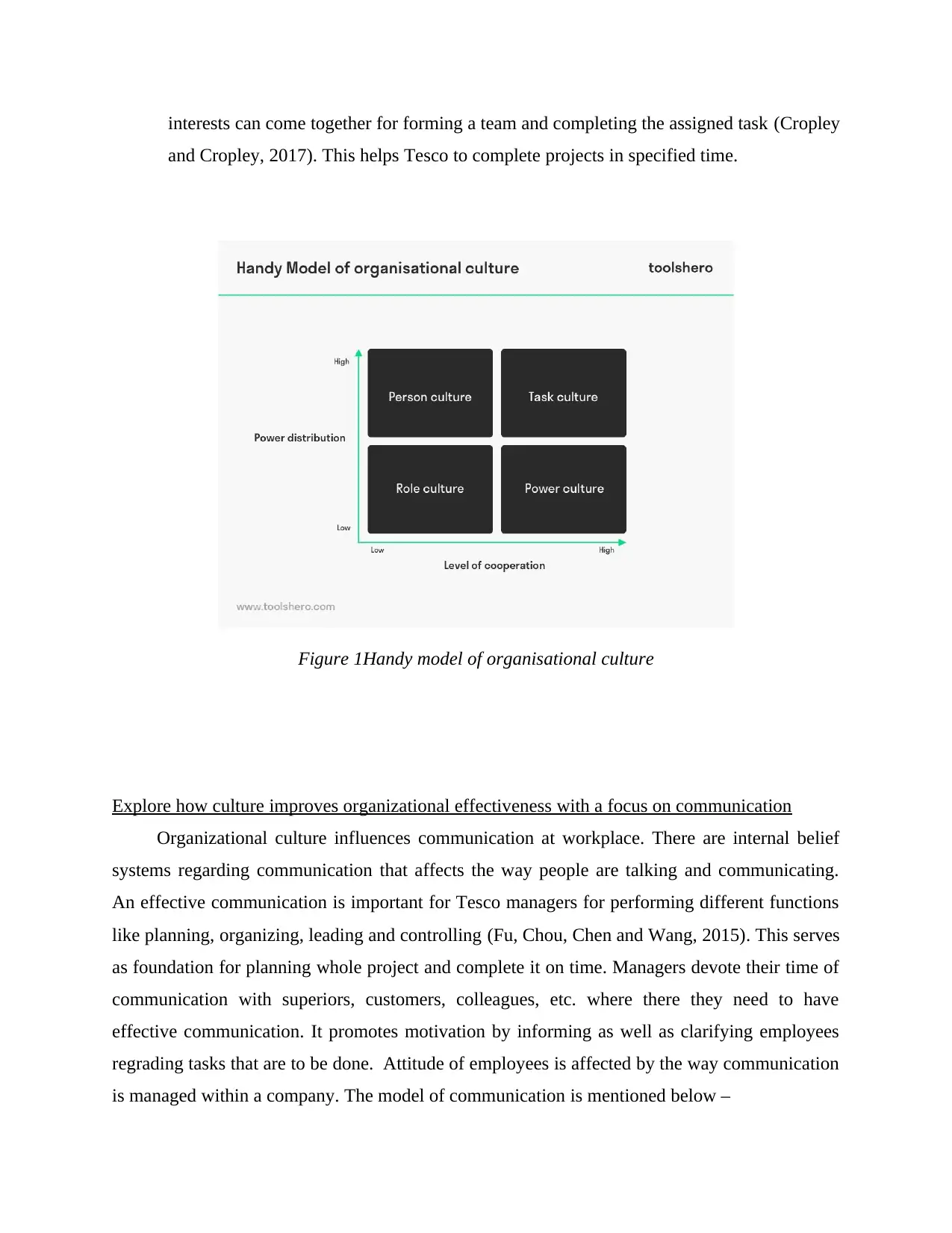
interests can come together for forming a team and completing the assigned task (Cropley
and Cropley, 2017). This helps Tesco to complete projects in specified time.
Figure 1Handy model of organisational culture
Explore how culture improves organizational effectiveness with a focus on communication
Organizational culture influences communication at workplace. There are internal belief
systems regarding communication that affects the way people are talking and communicating.
An effective communication is important for Tesco managers for performing different functions
like planning, organizing, leading and controlling (Fu, Chou, Chen and Wang, 2015). This serves
as foundation for planning whole project and complete it on time. Managers devote their time of
communication with superiors, customers, colleagues, etc. where there they need to have
effective communication. It promotes motivation by informing as well as clarifying employees
regrading tasks that are to be done. Attitude of employees is affected by the way communication
is managed within a company. The model of communication is mentioned below –
and Cropley, 2017). This helps Tesco to complete projects in specified time.
Figure 1Handy model of organisational culture
Explore how culture improves organizational effectiveness with a focus on communication
Organizational culture influences communication at workplace. There are internal belief
systems regarding communication that affects the way people are talking and communicating.
An effective communication is important for Tesco managers for performing different functions
like planning, organizing, leading and controlling (Fu, Chou, Chen and Wang, 2015). This serves
as foundation for planning whole project and complete it on time. Managers devote their time of
communication with superiors, customers, colleagues, etc. where there they need to have
effective communication. It promotes motivation by informing as well as clarifying employees
regrading tasks that are to be done. Attitude of employees is affected by the way communication
is managed within a company. The model of communication is mentioned below –
Paraphrase This Document
Need a fresh take? Get an instant paraphrase of this document with our AI Paraphraser
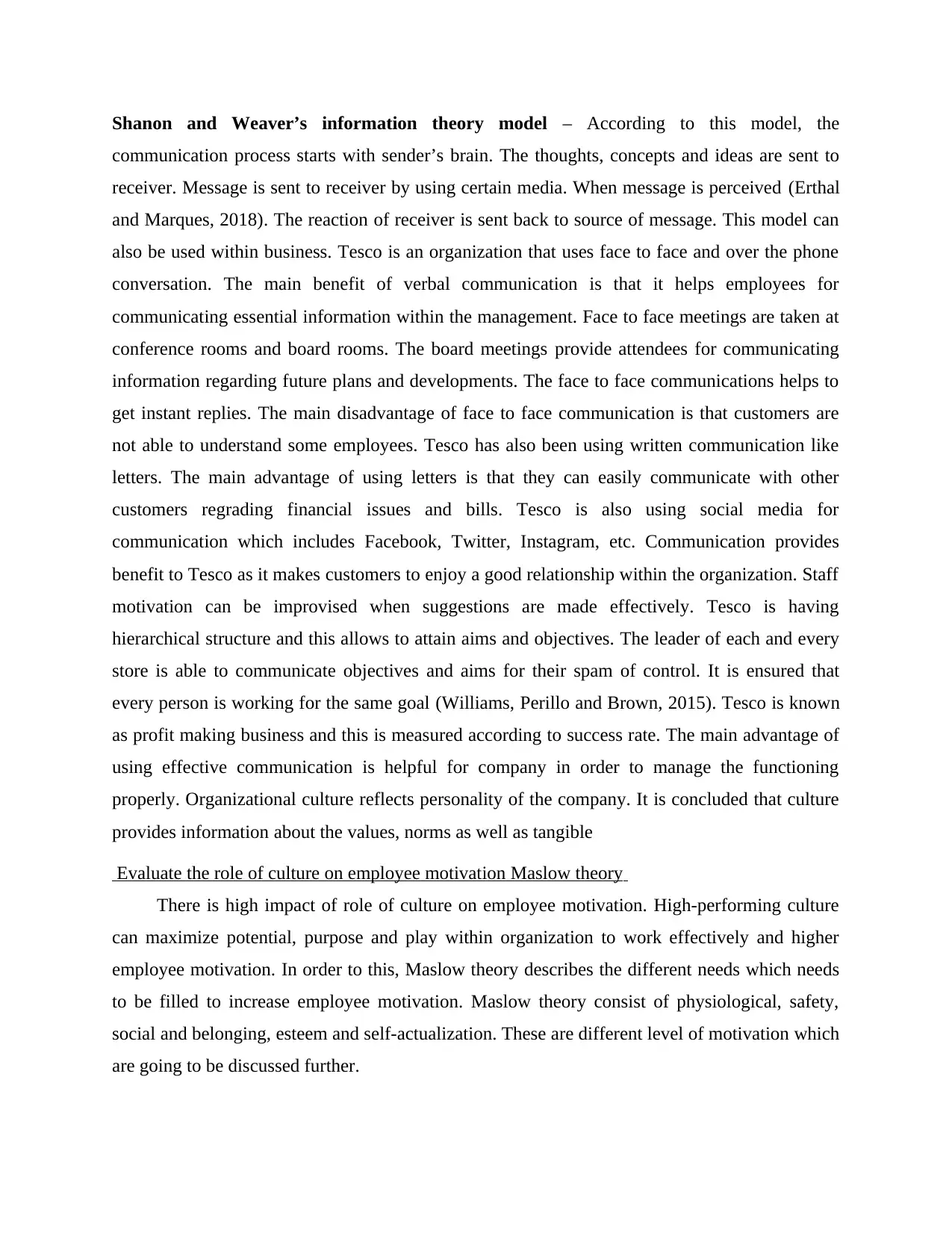
Shanon and Weaver’s information theory model – According to this model, the
communication process starts with sender’s brain. The thoughts, concepts and ideas are sent to
receiver. Message is sent to receiver by using certain media. When message is perceived (Erthal
and Marques, 2018). The reaction of receiver is sent back to source of message. This model can
also be used within business. Tesco is an organization that uses face to face and over the phone
conversation. The main benefit of verbal communication is that it helps employees for
communicating essential information within the management. Face to face meetings are taken at
conference rooms and board rooms. The board meetings provide attendees for communicating
information regarding future plans and developments. The face to face communications helps to
get instant replies. The main disadvantage of face to face communication is that customers are
not able to understand some employees. Tesco has also been using written communication like
letters. The main advantage of using letters is that they can easily communicate with other
customers regrading financial issues and bills. Tesco is also using social media for
communication which includes Facebook, Twitter, Instagram, etc. Communication provides
benefit to Tesco as it makes customers to enjoy a good relationship within the organization. Staff
motivation can be improvised when suggestions are made effectively. Tesco is having
hierarchical structure and this allows to attain aims and objectives. The leader of each and every
store is able to communicate objectives and aims for their spam of control. It is ensured that
every person is working for the same goal (Williams, Perillo and Brown, 2015). Tesco is known
as profit making business and this is measured according to success rate. The main advantage of
using effective communication is helpful for company in order to manage the functioning
properly. Organizational culture reflects personality of the company. It is concluded that culture
provides information about the values, norms as well as tangible
Evaluate the role of culture on employee motivation Maslow theory
There is high impact of role of culture on employee motivation. High-performing culture
can maximize potential, purpose and play within organization to work effectively and higher
employee motivation. In order to this, Maslow theory describes the different needs which needs
to be filled to increase employee motivation. Maslow theory consist of physiological, safety,
social and belonging, esteem and self-actualization. These are different level of motivation which
are going to be discussed further.
communication process starts with sender’s brain. The thoughts, concepts and ideas are sent to
receiver. Message is sent to receiver by using certain media. When message is perceived (Erthal
and Marques, 2018). The reaction of receiver is sent back to source of message. This model can
also be used within business. Tesco is an organization that uses face to face and over the phone
conversation. The main benefit of verbal communication is that it helps employees for
communicating essential information within the management. Face to face meetings are taken at
conference rooms and board rooms. The board meetings provide attendees for communicating
information regarding future plans and developments. The face to face communications helps to
get instant replies. The main disadvantage of face to face communication is that customers are
not able to understand some employees. Tesco has also been using written communication like
letters. The main advantage of using letters is that they can easily communicate with other
customers regrading financial issues and bills. Tesco is also using social media for
communication which includes Facebook, Twitter, Instagram, etc. Communication provides
benefit to Tesco as it makes customers to enjoy a good relationship within the organization. Staff
motivation can be improvised when suggestions are made effectively. Tesco is having
hierarchical structure and this allows to attain aims and objectives. The leader of each and every
store is able to communicate objectives and aims for their spam of control. It is ensured that
every person is working for the same goal (Williams, Perillo and Brown, 2015). Tesco is known
as profit making business and this is measured according to success rate. The main advantage of
using effective communication is helpful for company in order to manage the functioning
properly. Organizational culture reflects personality of the company. It is concluded that culture
provides information about the values, norms as well as tangible
Evaluate the role of culture on employee motivation Maslow theory
There is high impact of role of culture on employee motivation. High-performing culture
can maximize potential, purpose and play within organization to work effectively and higher
employee motivation. In order to this, Maslow theory describes the different needs which needs
to be filled to increase employee motivation. Maslow theory consist of physiological, safety,
social and belonging, esteem and self-actualization. These are different level of motivation which
are going to be discussed further.
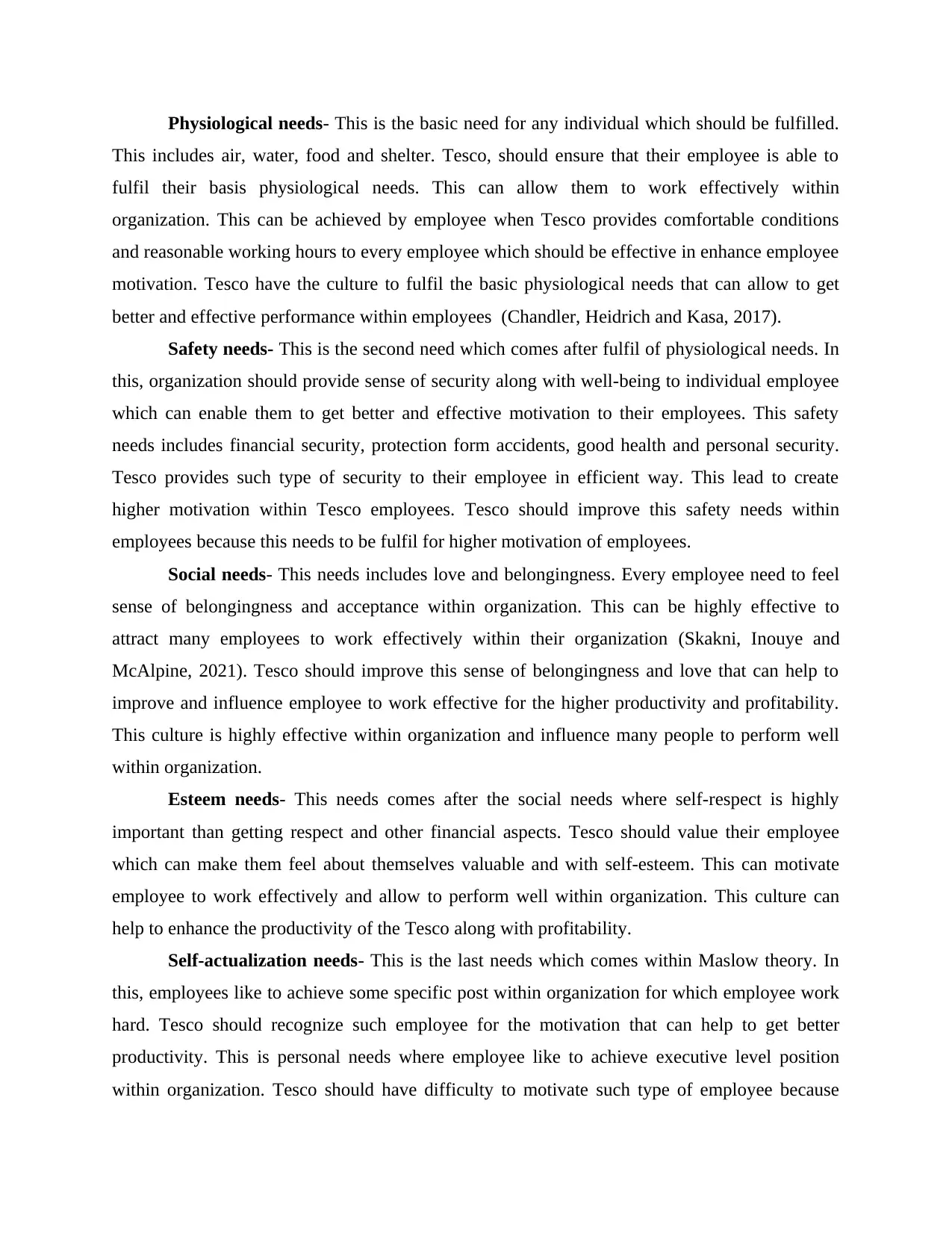
Physiological needs- This is the basic need for any individual which should be fulfilled.
This includes air, water, food and shelter. Tesco, should ensure that their employee is able to
fulfil their basis physiological needs. This can allow them to work effectively within
organization. This can be achieved by employee when Tesco provides comfortable conditions
and reasonable working hours to every employee which should be effective in enhance employee
motivation. Tesco have the culture to fulfil the basic physiological needs that can allow to get
better and effective performance within employees (Chandler, Heidrich and Kasa, 2017).
Safety needs- This is the second need which comes after fulfil of physiological needs. In
this, organization should provide sense of security along with well-being to individual employee
which can enable them to get better and effective motivation to their employees. This safety
needs includes financial security, protection form accidents, good health and personal security.
Tesco provides such type of security to their employee in efficient way. This lead to create
higher motivation within Tesco employees. Tesco should improve this safety needs within
employees because this needs to be fulfil for higher motivation of employees.
Social needs- This needs includes love and belongingness. Every employee need to feel
sense of belongingness and acceptance within organization. This can be highly effective to
attract many employees to work effectively within their organization (Skakni, Inouye and
McAlpine, 2021). Tesco should improve this sense of belongingness and love that can help to
improve and influence employee to work effective for the higher productivity and profitability.
This culture is highly effective within organization and influence many people to perform well
within organization.
Esteem needs- This needs comes after the social needs where self-respect is highly
important than getting respect and other financial aspects. Tesco should value their employee
which can make them feel about themselves valuable and with self-esteem. This can motivate
employee to work effectively and allow to perform well within organization. This culture can
help to enhance the productivity of the Tesco along with profitability.
Self-actualization needs- This is the last needs which comes within Maslow theory. In
this, employees like to achieve some specific post within organization for which employee work
hard. Tesco should recognize such employee for the motivation that can help to get better
productivity. This is personal needs where employee like to achieve executive level position
within organization. Tesco should have difficulty to motivate such type of employee because
This includes air, water, food and shelter. Tesco, should ensure that their employee is able to
fulfil their basis physiological needs. This can allow them to work effectively within
organization. This can be achieved by employee when Tesco provides comfortable conditions
and reasonable working hours to every employee which should be effective in enhance employee
motivation. Tesco have the culture to fulfil the basic physiological needs that can allow to get
better and effective performance within employees (Chandler, Heidrich and Kasa, 2017).
Safety needs- This is the second need which comes after fulfil of physiological needs. In
this, organization should provide sense of security along with well-being to individual employee
which can enable them to get better and effective motivation to their employees. This safety
needs includes financial security, protection form accidents, good health and personal security.
Tesco provides such type of security to their employee in efficient way. This lead to create
higher motivation within Tesco employees. Tesco should improve this safety needs within
employees because this needs to be fulfil for higher motivation of employees.
Social needs- This needs includes love and belongingness. Every employee need to feel
sense of belongingness and acceptance within organization. This can be highly effective to
attract many employees to work effectively within their organization (Skakni, Inouye and
McAlpine, 2021). Tesco should improve this sense of belongingness and love that can help to
improve and influence employee to work effective for the higher productivity and profitability.
This culture is highly effective within organization and influence many people to perform well
within organization.
Esteem needs- This needs comes after the social needs where self-respect is highly
important than getting respect and other financial aspects. Tesco should value their employee
which can make them feel about themselves valuable and with self-esteem. This can motivate
employee to work effectively and allow to perform well within organization. This culture can
help to enhance the productivity of the Tesco along with profitability.
Self-actualization needs- This is the last needs which comes within Maslow theory. In
this, employees like to achieve some specific post within organization for which employee work
hard. Tesco should recognize such employee for the motivation that can help to get better
productivity. This is personal needs where employee like to achieve executive level position
within organization. Tesco should have difficulty to motivate such type of employee because
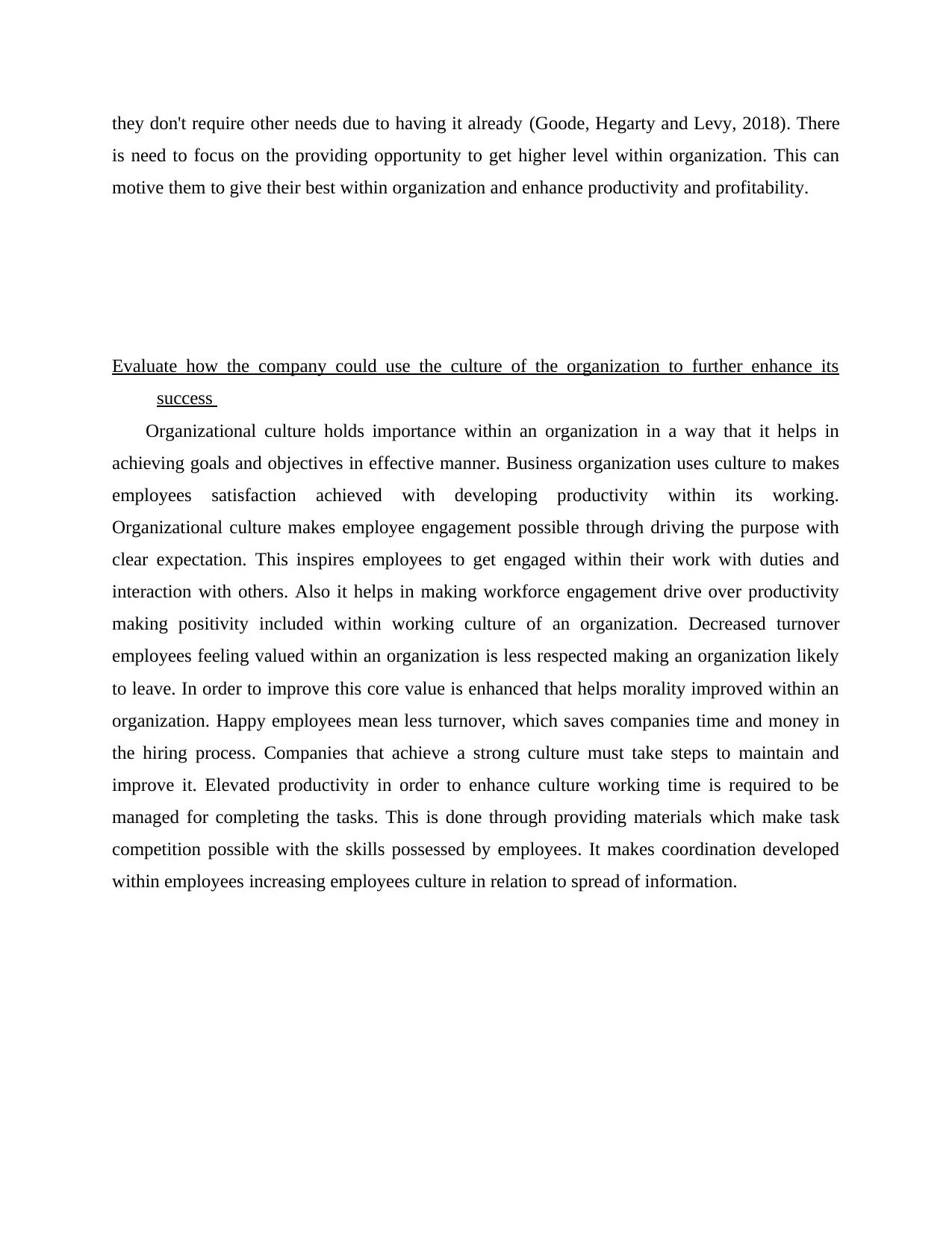
they don't require other needs due to having it already (Goode, Hegarty and Levy, 2018). There
is need to focus on the providing opportunity to get higher level within organization. This can
motive them to give their best within organization and enhance productivity and profitability.
Evaluate how the company could use the culture of the organization to further enhance its
success
Organizational culture holds importance within an organization in a way that it helps in
achieving goals and objectives in effective manner. Business organization uses culture to makes
employees satisfaction achieved with developing productivity within its working.
Organizational culture makes employee engagement possible through driving the purpose with
clear expectation. This inspires employees to get engaged within their work with duties and
interaction with others. Also it helps in making workforce engagement drive over productivity
making positivity included within working culture of an organization. Decreased turnover
employees feeling valued within an organization is less respected making an organization likely
to leave. In order to improve this core value is enhanced that helps morality improved within an
organization. Happy employees mean less turnover, which saves companies time and money in
the hiring process. Companies that achieve a strong culture must take steps to maintain and
improve it. Elevated productivity in order to enhance culture working time is required to be
managed for completing the tasks. This is done through providing materials which make task
competition possible with the skills possessed by employees. It makes coordination developed
within employees increasing employees culture in relation to spread of information.
is need to focus on the providing opportunity to get higher level within organization. This can
motive them to give their best within organization and enhance productivity and profitability.
Evaluate how the company could use the culture of the organization to further enhance its
success
Organizational culture holds importance within an organization in a way that it helps in
achieving goals and objectives in effective manner. Business organization uses culture to makes
employees satisfaction achieved with developing productivity within its working.
Organizational culture makes employee engagement possible through driving the purpose with
clear expectation. This inspires employees to get engaged within their work with duties and
interaction with others. Also it helps in making workforce engagement drive over productivity
making positivity included within working culture of an organization. Decreased turnover
employees feeling valued within an organization is less respected making an organization likely
to leave. In order to improve this core value is enhanced that helps morality improved within an
organization. Happy employees mean less turnover, which saves companies time and money in
the hiring process. Companies that achieve a strong culture must take steps to maintain and
improve it. Elevated productivity in order to enhance culture working time is required to be
managed for completing the tasks. This is done through providing materials which make task
competition possible with the skills possessed by employees. It makes coordination developed
within employees increasing employees culture in relation to spread of information.
Secure Best Marks with AI Grader
Need help grading? Try our AI Grader for instant feedback on your assignments.

Primary research
Q1 According to you, what type of organisational culture is followed in
Tesco?
Frequency
a) Positive 20
b) Negative 0
Q2 Do you think employees of Tesco are motivated? Frequency
a) Yes 10
b) No 10
Q3 As per your opinion, are Tesco employees satisfied by the rewards given
by company or motivation?
Frequency
a) Yes 16
b) No 4
Q4 Out of the following what are the ways used by Tesco to motivate
employees?
Frequency
a) Rewards 5
b) Appraisal 10
c) Bonus 5
Q5 Why do you recommend Tesco to any person for job? Frequency
a) Positive workplace culture 9
b) Ways of motivation used 4
c) Employee employer relationship 4
d) All of the above 3
Interpretations
Q1 According to you, what type of organisational culture is followed in
Tesco?
Frequency
a) Positive 20
Q1 According to you, what type of organisational culture is followed in
Tesco?
Frequency
a) Positive 20
b) Negative 0
Q2 Do you think employees of Tesco are motivated? Frequency
a) Yes 10
b) No 10
Q3 As per your opinion, are Tesco employees satisfied by the rewards given
by company or motivation?
Frequency
a) Yes 16
b) No 4
Q4 Out of the following what are the ways used by Tesco to motivate
employees?
Frequency
a) Rewards 5
b) Appraisal 10
c) Bonus 5
Q5 Why do you recommend Tesco to any person for job? Frequency
a) Positive workplace culture 9
b) Ways of motivation used 4
c) Employee employer relationship 4
d) All of the above 3
Interpretations
Q1 According to you, what type of organisational culture is followed in
Tesco?
Frequency
a) Positive 20
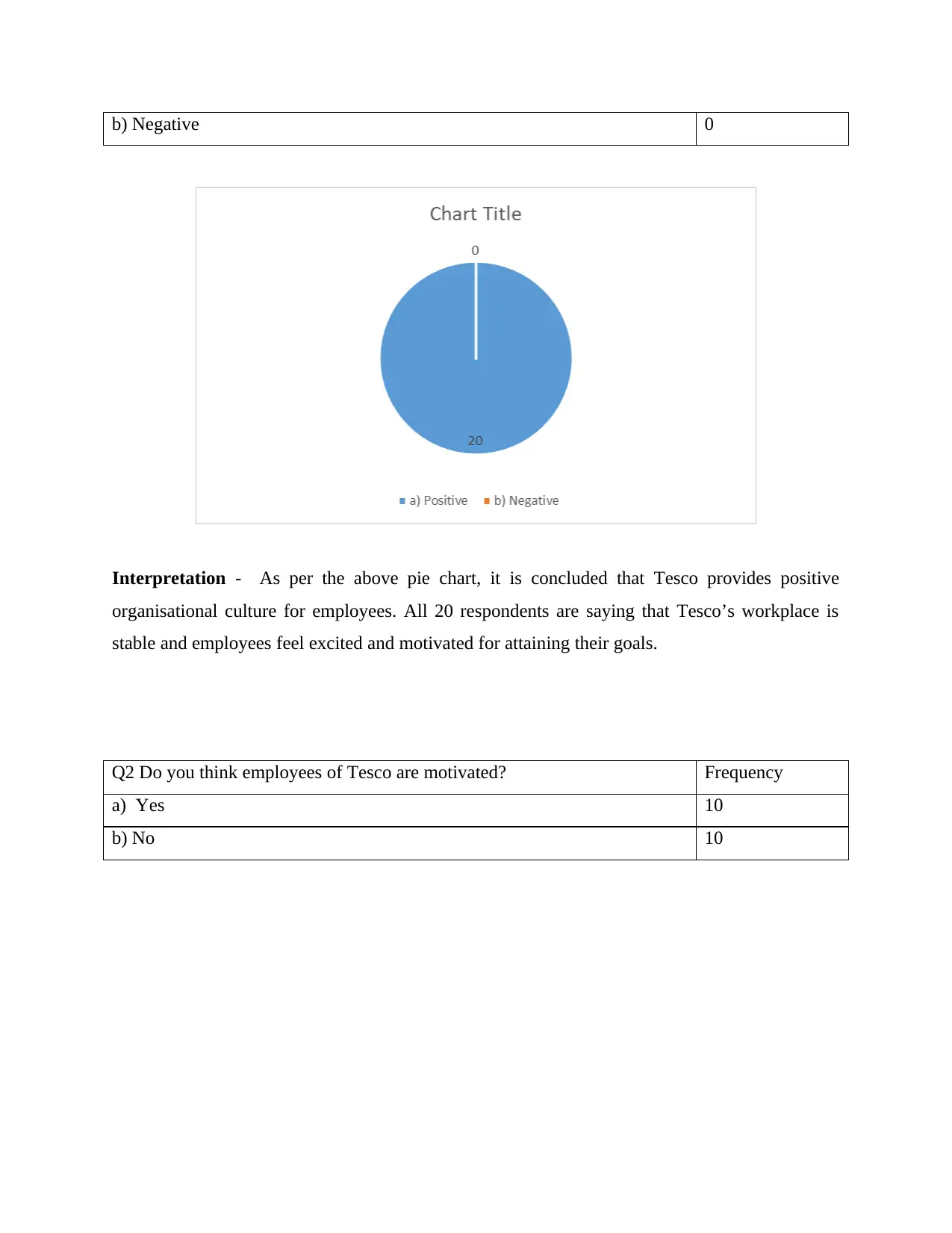
b) Negative 0
Interpretation - As per the above pie chart, it is concluded that Tesco provides positive
organisational culture for employees. All 20 respondents are saying that Tesco’s workplace is
stable and employees feel excited and motivated for attaining their goals.
Q2 Do you think employees of Tesco are motivated? Frequency
a) Yes 10
b) No 10
Interpretation - As per the above pie chart, it is concluded that Tesco provides positive
organisational culture for employees. All 20 respondents are saying that Tesco’s workplace is
stable and employees feel excited and motivated for attaining their goals.
Q2 Do you think employees of Tesco are motivated? Frequency
a) Yes 10
b) No 10
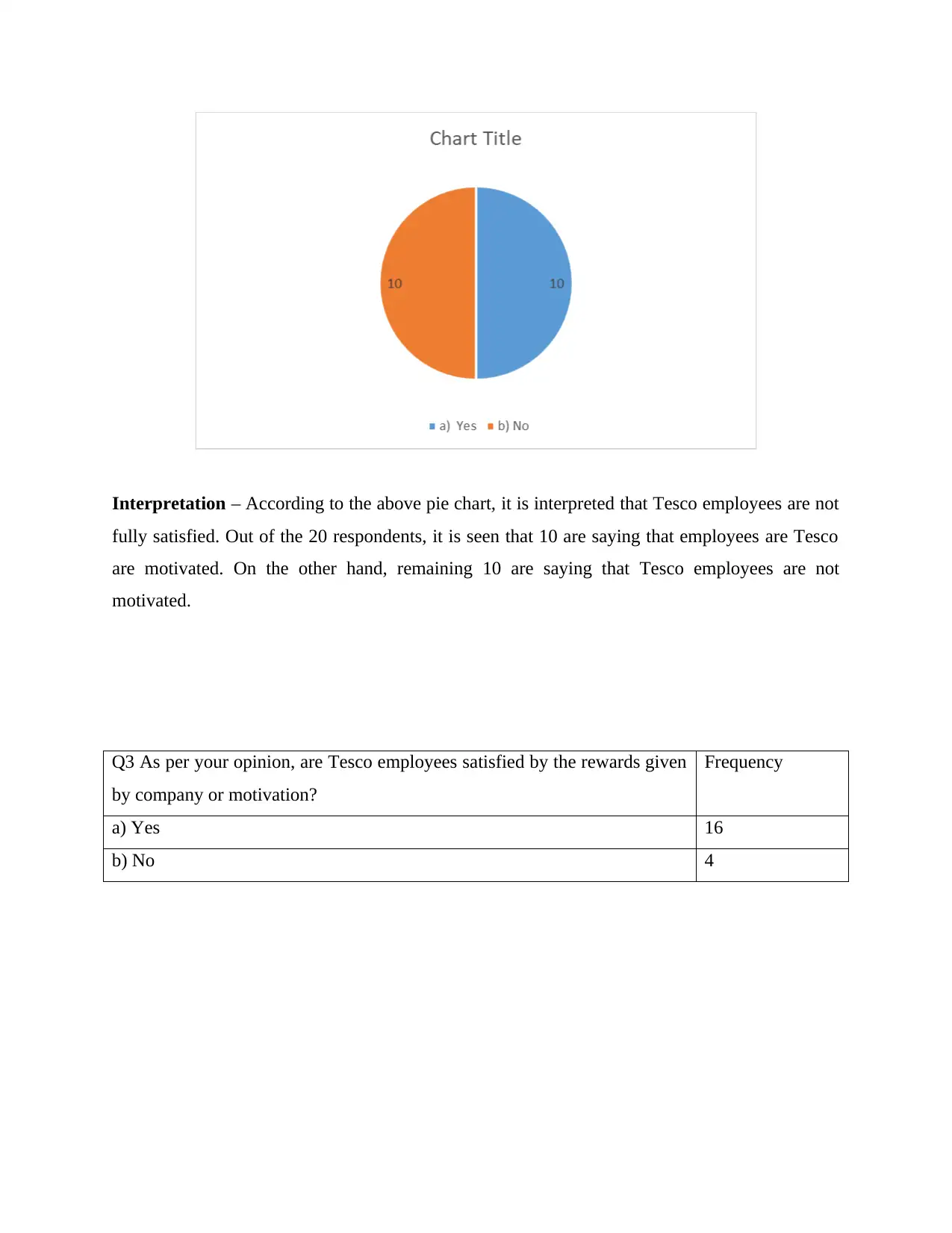
Interpretation – According to the above pie chart, it is interpreted that Tesco employees are not
fully satisfied. Out of the 20 respondents, it is seen that 10 are saying that employees are Tesco
are motivated. On the other hand, remaining 10 are saying that Tesco employees are not
motivated.
Q3 As per your opinion, are Tesco employees satisfied by the rewards given
by company or motivation?
Frequency
a) Yes 16
b) No 4
fully satisfied. Out of the 20 respondents, it is seen that 10 are saying that employees are Tesco
are motivated. On the other hand, remaining 10 are saying that Tesco employees are not
motivated.
Q3 As per your opinion, are Tesco employees satisfied by the rewards given
by company or motivation?
Frequency
a) Yes 16
b) No 4
Paraphrase This Document
Need a fresh take? Get an instant paraphrase of this document with our AI Paraphraser
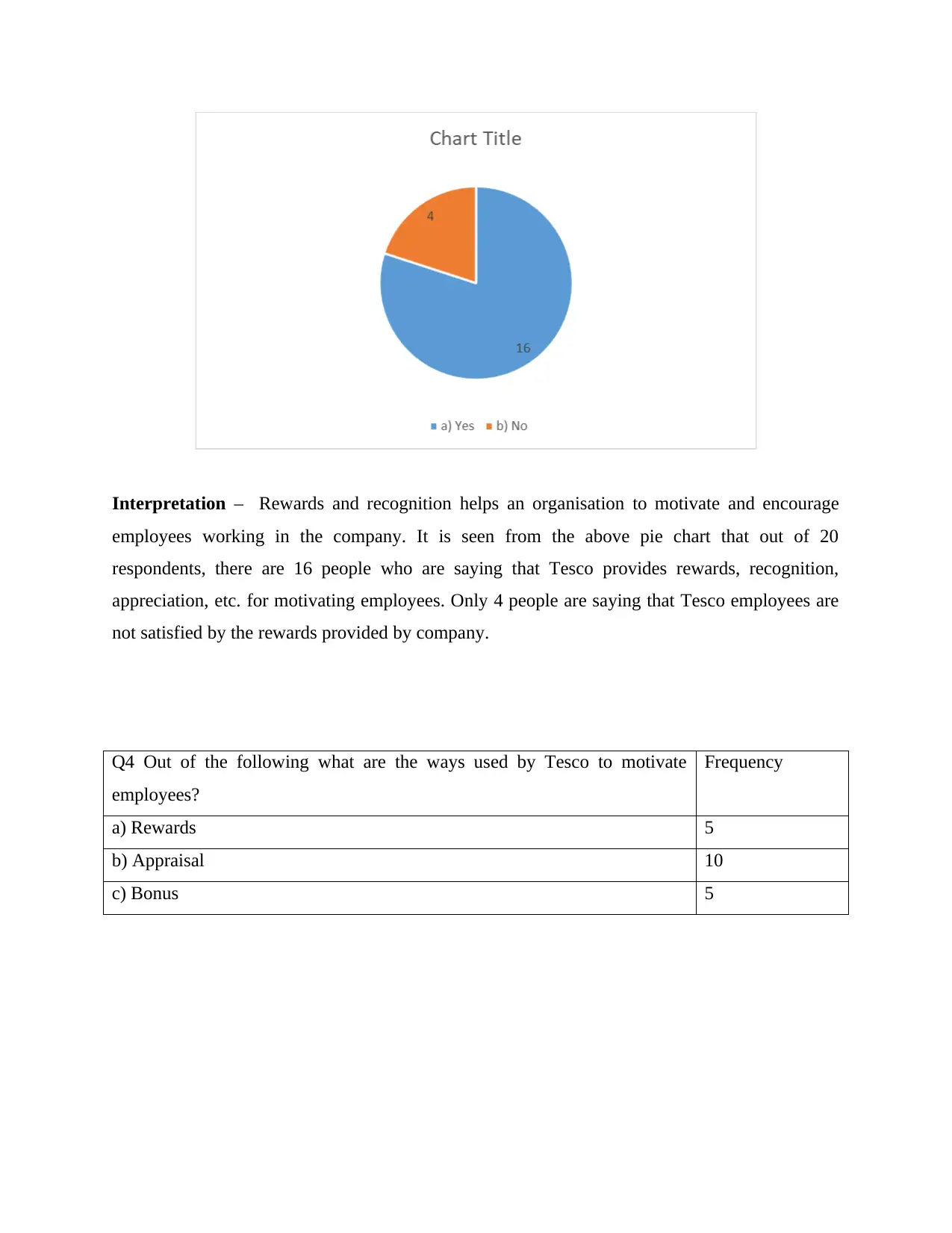
Interpretation – Rewards and recognition helps an organisation to motivate and encourage
employees working in the company. It is seen from the above pie chart that out of 20
respondents, there are 16 people who are saying that Tesco provides rewards, recognition,
appreciation, etc. for motivating employees. Only 4 people are saying that Tesco employees are
not satisfied by the rewards provided by company.
Q4 Out of the following what are the ways used by Tesco to motivate
employees?
Frequency
a) Rewards 5
b) Appraisal 10
c) Bonus 5
employees working in the company. It is seen from the above pie chart that out of 20
respondents, there are 16 people who are saying that Tesco provides rewards, recognition,
appreciation, etc. for motivating employees. Only 4 people are saying that Tesco employees are
not satisfied by the rewards provided by company.
Q4 Out of the following what are the ways used by Tesco to motivate
employees?
Frequency
a) Rewards 5
b) Appraisal 10
c) Bonus 5
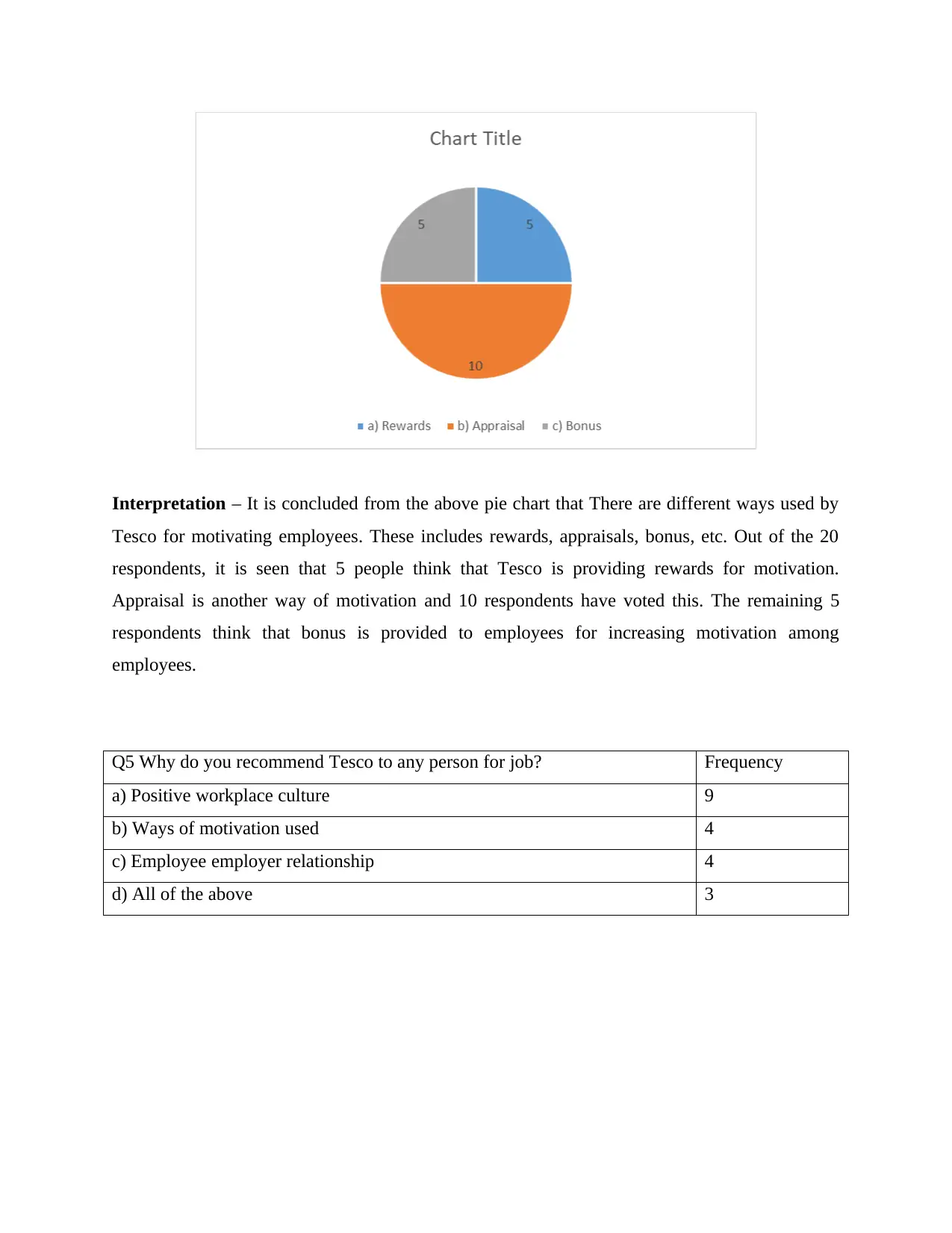
Interpretation – It is concluded from the above pie chart that There are different ways used by
Tesco for motivating employees. These includes rewards, appraisals, bonus, etc. Out of the 20
respondents, it is seen that 5 people think that Tesco is providing rewards for motivation.
Appraisal is another way of motivation and 10 respondents have voted this. The remaining 5
respondents think that bonus is provided to employees for increasing motivation among
employees.
Q5 Why do you recommend Tesco to any person for job? Frequency
a) Positive workplace culture 9
b) Ways of motivation used 4
c) Employee employer relationship 4
d) All of the above 3
Tesco for motivating employees. These includes rewards, appraisals, bonus, etc. Out of the 20
respondents, it is seen that 5 people think that Tesco is providing rewards for motivation.
Appraisal is another way of motivation and 10 respondents have voted this. The remaining 5
respondents think that bonus is provided to employees for increasing motivation among
employees.
Q5 Why do you recommend Tesco to any person for job? Frequency
a) Positive workplace culture 9
b) Ways of motivation used 4
c) Employee employer relationship 4
d) All of the above 3
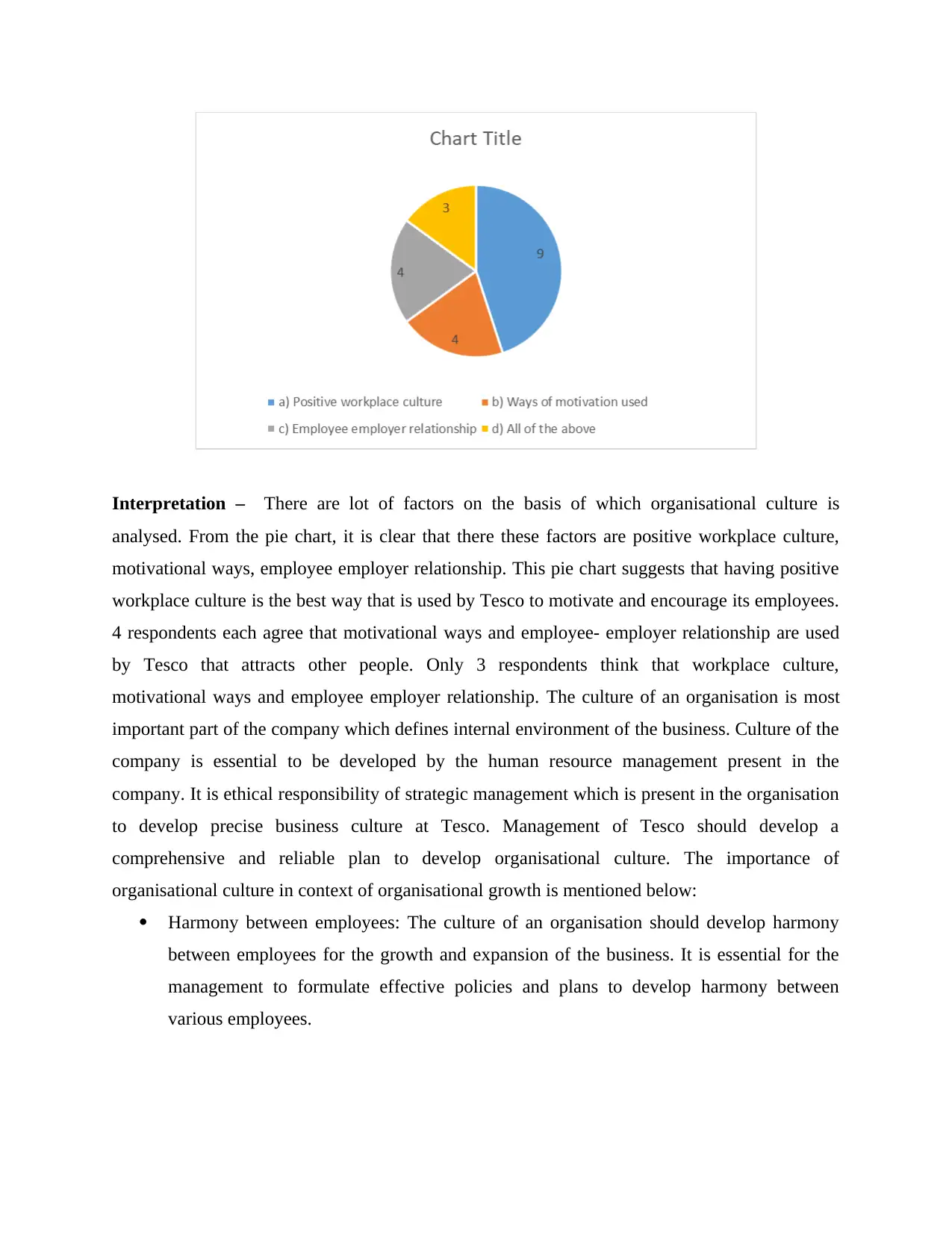
Interpretation – There are lot of factors on the basis of which organisational culture is
analysed. From the pie chart, it is clear that there these factors are positive workplace culture,
motivational ways, employee employer relationship. This pie chart suggests that having positive
workplace culture is the best way that is used by Tesco to motivate and encourage its employees.
4 respondents each agree that motivational ways and employee- employer relationship are used
by Tesco that attracts other people. Only 3 respondents think that workplace culture,
motivational ways and employee employer relationship. The culture of an organisation is most
important part of the company which defines internal environment of the business. Culture of the
company is essential to be developed by the human resource management present in the
company. It is ethical responsibility of strategic management which is present in the organisation
to develop precise business culture at Tesco. Management of Tesco should develop a
comprehensive and reliable plan to develop organisational culture. The importance of
organisational culture in context of organisational growth is mentioned below:
Harmony between employees: The culture of an organisation should develop harmony
between employees for the growth and expansion of the business. It is essential for the
management to formulate effective policies and plans to develop harmony between
various employees.
analysed. From the pie chart, it is clear that there these factors are positive workplace culture,
motivational ways, employee employer relationship. This pie chart suggests that having positive
workplace culture is the best way that is used by Tesco to motivate and encourage its employees.
4 respondents each agree that motivational ways and employee- employer relationship are used
by Tesco that attracts other people. Only 3 respondents think that workplace culture,
motivational ways and employee employer relationship. The culture of an organisation is most
important part of the company which defines internal environment of the business. Culture of the
company is essential to be developed by the human resource management present in the
company. It is ethical responsibility of strategic management which is present in the organisation
to develop precise business culture at Tesco. Management of Tesco should develop a
comprehensive and reliable plan to develop organisational culture. The importance of
organisational culture in context of organisational growth is mentioned below:
Harmony between employees: The culture of an organisation should develop harmony
between employees for the growth and expansion of the business. It is essential for the
management to formulate effective policies and plans to develop harmony between
various employees.
Secure Best Marks with AI Grader
Need help grading? Try our AI Grader for instant feedback on your assignments.
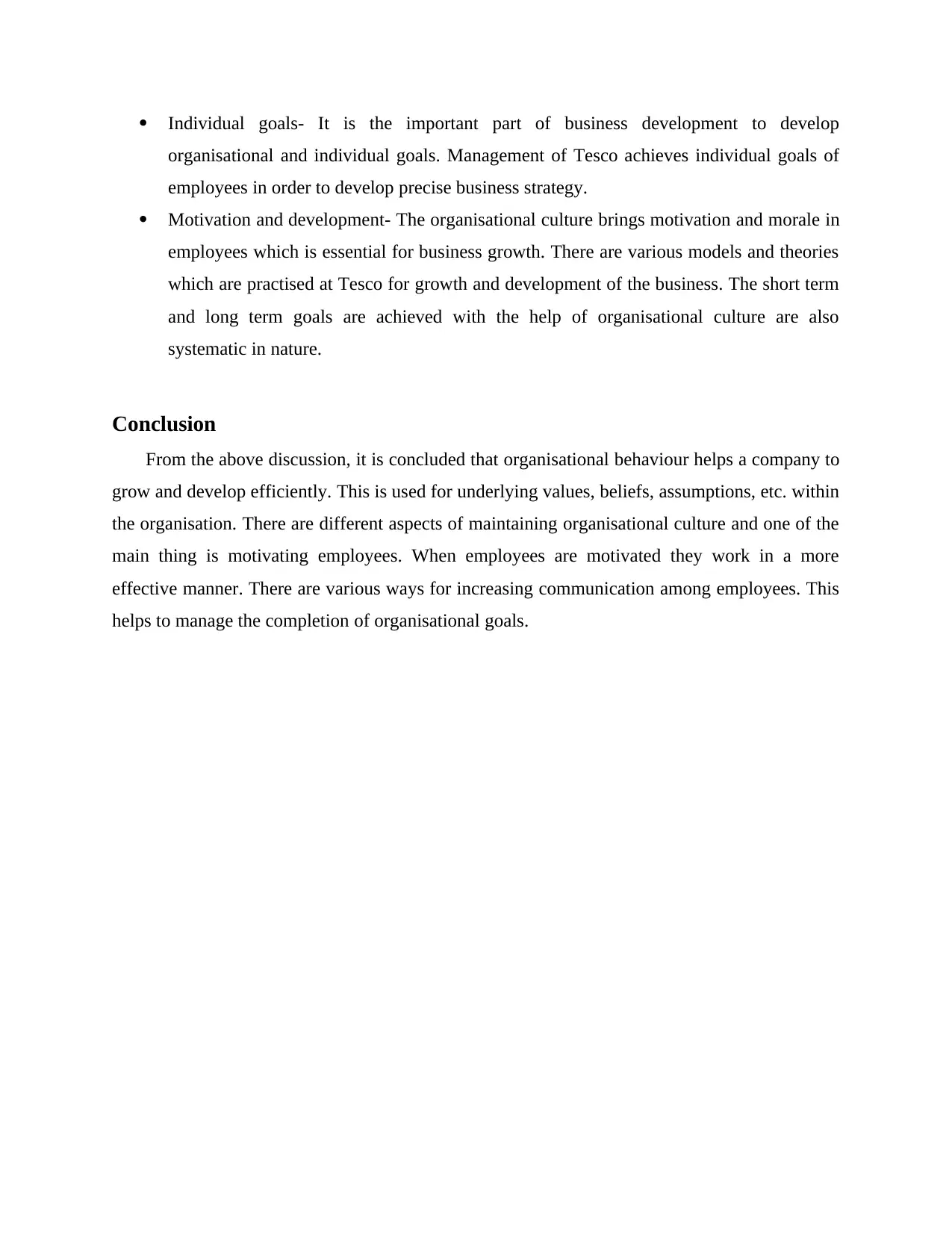
Individual goals- It is the important part of business development to develop
organisational and individual goals. Management of Tesco achieves individual goals of
employees in order to develop precise business strategy.
Motivation and development- The organisational culture brings motivation and morale in
employees which is essential for business growth. There are various models and theories
which are practised at Tesco for growth and development of the business. The short term
and long term goals are achieved with the help of organisational culture are also
systematic in nature.
Conclusion
From the above discussion, it is concluded that organisational behaviour helps a company to
grow and develop efficiently. This is used for underlying values, beliefs, assumptions, etc. within
the organisation. There are different aspects of maintaining organisational culture and one of the
main thing is motivating employees. When employees are motivated they work in a more
effective manner. There are various ways for increasing communication among employees. This
helps to manage the completion of organisational goals.
organisational and individual goals. Management of Tesco achieves individual goals of
employees in order to develop precise business strategy.
Motivation and development- The organisational culture brings motivation and morale in
employees which is essential for business growth. There are various models and theories
which are practised at Tesco for growth and development of the business. The short term
and long term goals are achieved with the help of organisational culture are also
systematic in nature.
Conclusion
From the above discussion, it is concluded that organisational behaviour helps a company to
grow and develop efficiently. This is used for underlying values, beliefs, assumptions, etc. within
the organisation. There are different aspects of maintaining organisational culture and one of the
main thing is motivating employees. When employees are motivated they work in a more
effective manner. There are various ways for increasing communication among employees. This
helps to manage the completion of organisational goals.
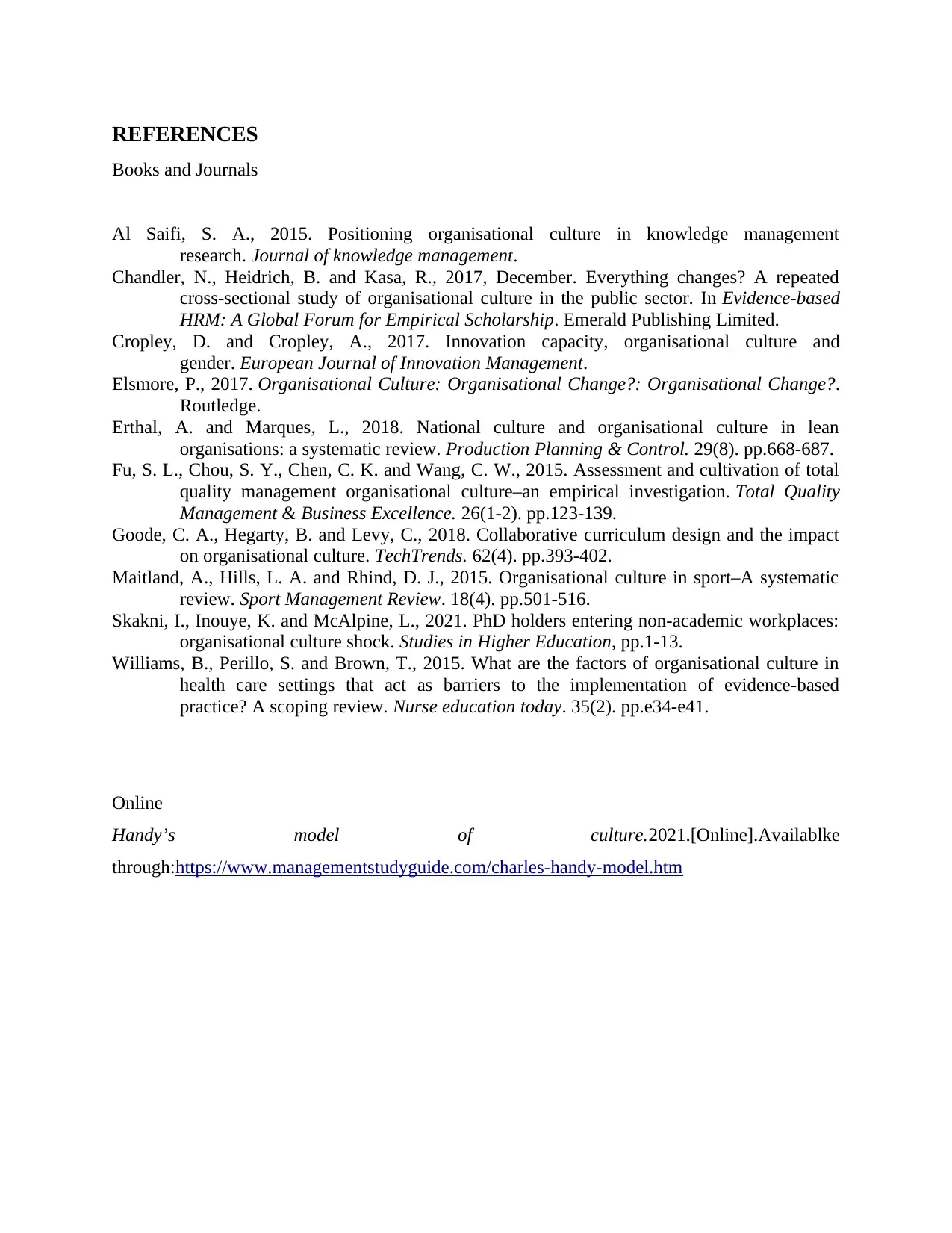
REFERENCES
Books and Journals
Al Saifi, S. A., 2015. Positioning organisational culture in knowledge management
research. Journal of knowledge management.
Chandler, N., Heidrich, B. and Kasa, R., 2017, December. Everything changes? A repeated
cross-sectional study of organisational culture in the public sector. In Evidence-based
HRM: A Global Forum for Empirical Scholarship. Emerald Publishing Limited.
Cropley, D. and Cropley, A., 2017. Innovation capacity, organisational culture and
gender. European Journal of Innovation Management.
Elsmore, P., 2017. Organisational Culture: Organisational Change?: Organisational Change?.
Routledge.
Erthal, A. and Marques, L., 2018. National culture and organisational culture in lean
organisations: a systematic review. Production Planning & Control. 29(8). pp.668-687.
Fu, S. L., Chou, S. Y., Chen, C. K. and Wang, C. W., 2015. Assessment and cultivation of total
quality management organisational culture–an empirical investigation. Total Quality
Management & Business Excellence. 26(1-2). pp.123-139.
Goode, C. A., Hegarty, B. and Levy, C., 2018. Collaborative curriculum design and the impact
on organisational culture. TechTrends. 62(4). pp.393-402.
Maitland, A., Hills, L. A. and Rhind, D. J., 2015. Organisational culture in sport–A systematic
review. Sport Management Review. 18(4). pp.501-516.
Skakni, I., Inouye, K. and McAlpine, L., 2021. PhD holders entering non-academic workplaces:
organisational culture shock. Studies in Higher Education, pp.1-13.
Williams, B., Perillo, S. and Brown, T., 2015. What are the factors of organisational culture in
health care settings that act as barriers to the implementation of evidence-based
practice? A scoping review. Nurse education today. 35(2). pp.e34-e41.
Online
Handy’s model of culture.2021.[Online].Availablke
through:https://www.managementstudyguide.com/charles-handy-model.htm
Books and Journals
Al Saifi, S. A., 2015. Positioning organisational culture in knowledge management
research. Journal of knowledge management.
Chandler, N., Heidrich, B. and Kasa, R., 2017, December. Everything changes? A repeated
cross-sectional study of organisational culture in the public sector. In Evidence-based
HRM: A Global Forum for Empirical Scholarship. Emerald Publishing Limited.
Cropley, D. and Cropley, A., 2017. Innovation capacity, organisational culture and
gender. European Journal of Innovation Management.
Elsmore, P., 2017. Organisational Culture: Organisational Change?: Organisational Change?.
Routledge.
Erthal, A. and Marques, L., 2018. National culture and organisational culture in lean
organisations: a systematic review. Production Planning & Control. 29(8). pp.668-687.
Fu, S. L., Chou, S. Y., Chen, C. K. and Wang, C. W., 2015. Assessment and cultivation of total
quality management organisational culture–an empirical investigation. Total Quality
Management & Business Excellence. 26(1-2). pp.123-139.
Goode, C. A., Hegarty, B. and Levy, C., 2018. Collaborative curriculum design and the impact
on organisational culture. TechTrends. 62(4). pp.393-402.
Maitland, A., Hills, L. A. and Rhind, D. J., 2015. Organisational culture in sport–A systematic
review. Sport Management Review. 18(4). pp.501-516.
Skakni, I., Inouye, K. and McAlpine, L., 2021. PhD holders entering non-academic workplaces:
organisational culture shock. Studies in Higher Education, pp.1-13.
Williams, B., Perillo, S. and Brown, T., 2015. What are the factors of organisational culture in
health care settings that act as barriers to the implementation of evidence-based
practice? A scoping review. Nurse education today. 35(2). pp.e34-e41.
Online
Handy’s model of culture.2021.[Online].Availablke
through:https://www.managementstudyguide.com/charles-handy-model.htm
1 out of 15
![[object Object]](/_next/static/media/star-bottom.7253800d.svg)





